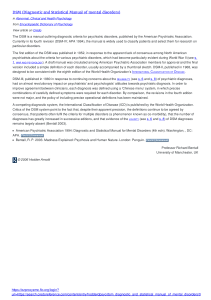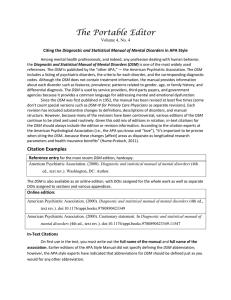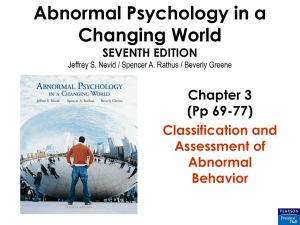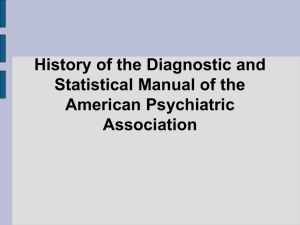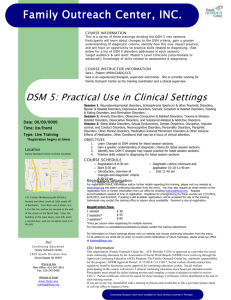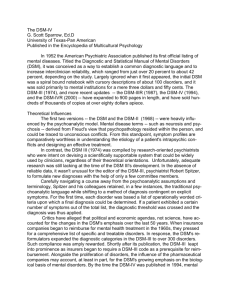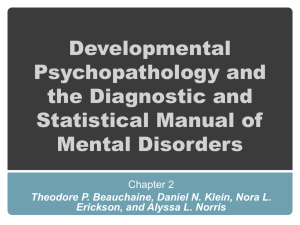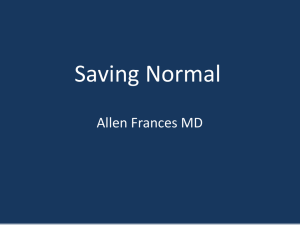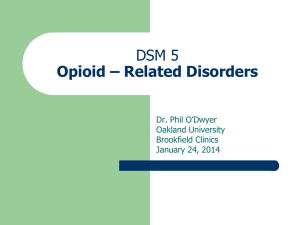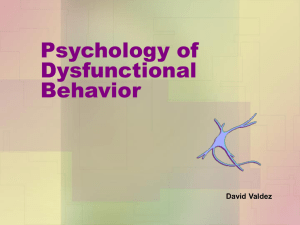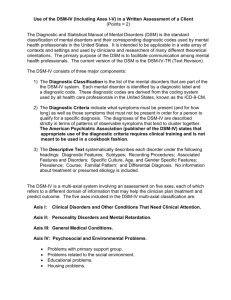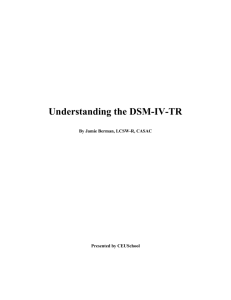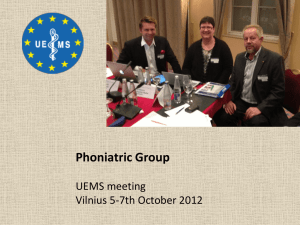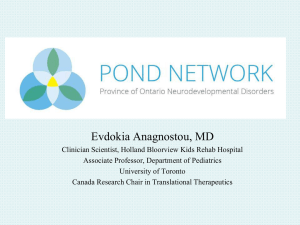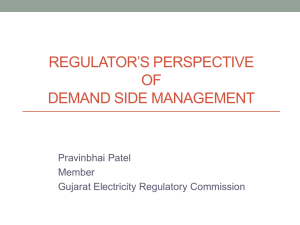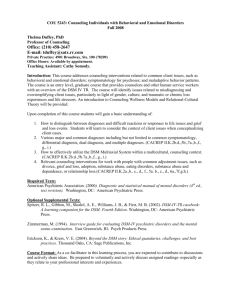Classification of mental disorders
advertisement
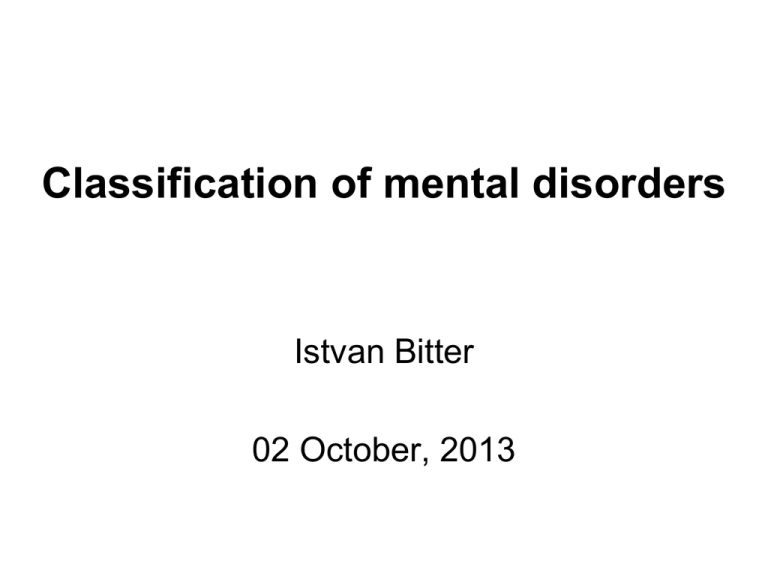
Classification of mental disorders Istvan Bitter 02 October, 2013 Purpose of Diagnosis in Psychiatry 1. 2. 3. 4. 5. Order and Structure Communication Predict Outcome Decide Appropriate Treatment Assist in the search for pathophysiology and etiology Procedural considerations for Assessment • Classification and diagnosis usually follow clinical interviewing to determine diagnosis (i.e. a diagnostic interview) • A diagnostic interview is the most widely used assessment tool in clinical psychiatry Assessments • Psychological: Clinical interviews and reports: Interactional style; empathy, Situational factors, paradigm • Biological: Scanning brain function (PET, CT, MRI, FMRI, Neurochemical; • Psychophysiological measures Components of Psychiatric Assessment • • • • • • • • • • • • • Identifying data Chief Complaint History of Present Illness Past Psychiatric History Past Medical History Medications Allergies Family History Social History Medical Review of Systems Mental Status Exam Diagnosis (incl. comorbidities) Treatment Plan Interview topics- mental status examination – General appearance – Speech and thought – Consciousness – – – – - Memory - Attention/concentration - General information fund - Perception Mood and Affect Insight and judgement Obsessions and compulsions Intelligence/higher intellectual functioning General Appearance and Behavior • • • • • Describe appearance/behavior Grooming, hygiene, facial expressions Jewelry, tattoos, Attitude towards examiner Does pt look stated age? Psychomotor Activity • • • • Posture Describe motor activity Does s/he sit quietly or agitated Note abnormal movements – – – – – Tics EPS (extrapyramidal symptoms) mannerisms catatonia TD (tardive dyskinesia) Speech • Note patient’s speech – – – – – – – RRR (regular in rate and rhythm) Pressured, slow, normal Loud, soft Poverty of speech/content of speech Latent Echolalia Aphasia • May want to include a sample of speech Thought Form • Describe thought process—this is inferred by pattern of speech – – – – – – – Logical and goal directed Concrete Preservative Circumstantial, tangential Flight of ideas Poverty of content Thought blocking Mood • Mood is determined by PATIENT’S REPORT • Mood is an emotional attitude that is relatively sustained – – – – – Euthymic Depressed Anxious Euphoric Irritable Affect • Affect refers to way pt conveys her/his emotional state, what is OBSERVED – Appropriate vs inappropriate – Full – blunted – flat Thought Content • Describe Content of Thought – Hallucinations (auditory, visual, olfactory, gustatory, tactile + one: conaesthesia or conaestopathia) – Delusions – Ideas of Reference – Obsessions and Compulsions – Phobia – Distorted body image – Poverty of content – Suicidal incl. passive death wish/ Self Harm/ Homicidal ideation Sensorium and Cognition • Mini Mental Status Exam covers most of the components • Describe level of alertness • Orientation • Memory – Very short term: repeat 3 items – Short term: recall 3 items – Long term: events that occurred in past Sensorium and Cognitive Function • General Information – List 5 past presidents, current events • • • • • Calculations Serial 7’s vs 3’s Capacity to Read and Write Read text, write a sentence Visuospatial Ability – Copy design Sensorium and Cognitive Function • Attention • Serial 7’s, spell WORLD backwards • Abstraction – Interpret proverb • Don’t cry over spilt milk Insight and Judgment • Insight: does the pt understand her/his illness,understand need for treatment • Judgment: does the person make good choices? – Ask question: If you found a stamp, addressed envelope, what would you do?” PANSS: Positive and Negative Syndrome The Mini Mental State Examination (MMSE) Permission is hereby granted to reproduce this material for not-for-profit educational purposes only, provided The Hartford Institute for Geriatric Nursing, Division of Nursing, New York University is cited as the source. Available on the internet at www.hartfordign.org. E-mail notification of usage to: hartford.ign@nyu.edu. Maximum Score Orientation 5 () What is the (year) (season) (date) (day) (month)? 5 () Where are we (state) (country) (town) (hospital) (floor)? Registration 3 () Name 3 objects: 1 second to say each. Then ask the patient all 3 after you have said them. Give 1 point for each correct answer. Then repeat them until he/she learns all 3. Count trials and record. Trials ___________ Attention and Calculation 5 () Serial 7’s. 1 point for each correct answer. Stop after 5 answers. Alternatively spell “world” backward. Recall 3 () Ask for the 3 objects repeated above. Give 1 point for each correct answer. Language 2 () Name a pencil and watch. 1 () MMSE (2) Repeat the following “No ifs, ands, or buts” 3 () Follow a 3-stage command: “Take a paper in your hand, fold it in half, and put it on the floor.” 1 () Read and obey the following: CLOSE YOUR EYES 1 () Write a sentence. 1 () Copy the design shown. _____ Total Score ASSESS level of consciousness along a continuum ____________ Alert Drowsy Stupor Coma Diagnostic Manuals - A history • Diagnostic and Statistical Manual of Mental Disorders, (5th Edition, 2013) – DSM-5, American Psychiatric Association • International Statistical Classification of Diseases, Injuries and Causes of Death (10th version - 1993) – ICD-10, World Health Organization History of DSM • DSM I (1952) – established mainly by psychoanalysts to distinguish groups of psychoneurotic disorders, such as anxiety. – Interpretations of psychoneurotic disorders were mainstream Freudian (defence mechanisms). – Discourses of ‘reactions’ predominated. DSM II (1968) • 1950’s - 1960’s - psychoanalysis still dominated. Psychoneurotic problems became defined as ‘neurotic’ disturbances (e.g. hysteria) • In 1973, homosexuality was removed, replaced by ‘sexual orientation disturbance’ • There was little in the way of clear descriptions of ‘disorders’. All ‘symptoms’ were defined as ‘symbolic’ (of unconscious processes) DSM III (1980) – Completely new directions in psychiatry - instead of symptoms defined as ‘symbols’ - they were viewed as natural disease categories – Return to the world of medicine – Aims: research driven; operational criteria; based on ‘symptoms’ check list, not symbolic gestures – Outcome: the production of a science driven document – ego-dystonic homosexuality still included – Translated into 20 languages DSM-III Paradigm Shift • • • • • • Descriptive Non-etiologic focus Diagnostic criteria Multiaxial system Multiple diagnoses Reliability DSM III R (1987) • + self-defeating personality disorders • Post-traumatic stress disorder was introduced to account for repeated trauma in Vietnam veterans • Pressure groups altered the course of the DSM – ego-dystonic homosexuality removed DSM-IV • Diagnostic and Statistical Manual of Mental Disorders, (4th Edition 1994) – DSM-IV, American Psychiatric Association DSM-IV (1994) • Neurosis as a term is no longer in existence • Mental disorders included – DSM II = 85 disorders – DSM III = 265 disorders – DSM III-R = 292 disorders – DSM IV = 297 disorders DSM-IV TR, 2000 • Minor changes DSM-5, 2013 • Major changes summarized: http://www.dsm5.org/Documents/changes%20fr om%20dsm-iv-tr%20to%20dsm-5.pdf Reliability and Validity • Reliability – Consistent diagnoses – Interrater reliability – Clear methods of assessment, standardised symptoms • Validity – Construct validity – Etiological Validity: Consistent Causal Factors – Predictive Validity: Successful prognosis - most people with bipolar respond well to lithium carbonate, suggesting coherence in diagnostic group DSM and ICD • Advantages 1. Improve reliability of dx 2. Clarify dx and facilitate history taking 3. Clarify and facilitate process of differential diagnosis • Disadvantages 1. 2. False sense of certainty May sacrifice validity for reliability RELIABILITY: capacity of individuals to agree VALIDITY: capacity to make useful predictions 3. Treat dx like checklist and forget about patient as a person ICD-10 • International Statistical Classification of Diseases and Related Health Problems 10th Revision (ICD-10) Version for 2010 • Chapter V Mental and behavioural disorders (F00-F99) • http://apps.who.int/classifications/icd10/browse/ 2010/en#/V Thank you for your attention
